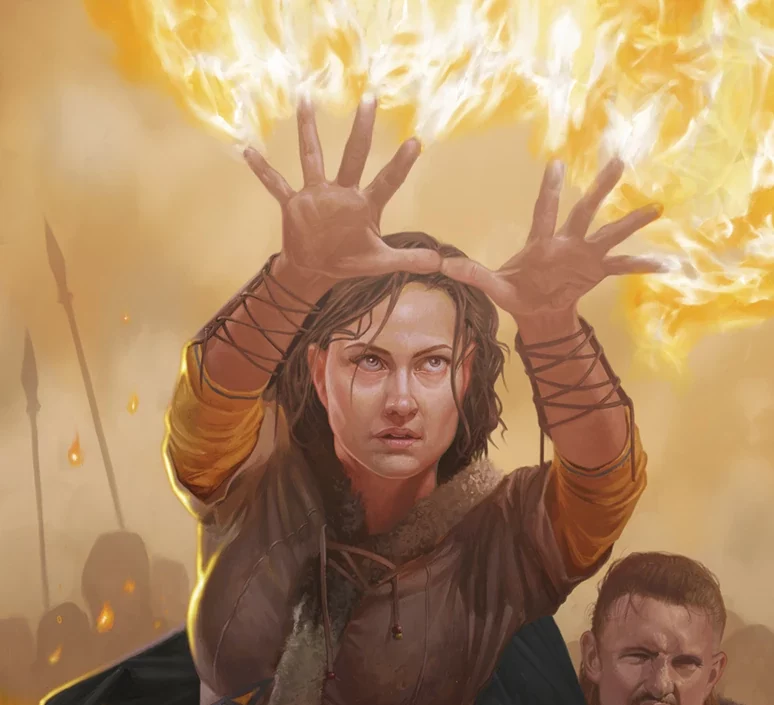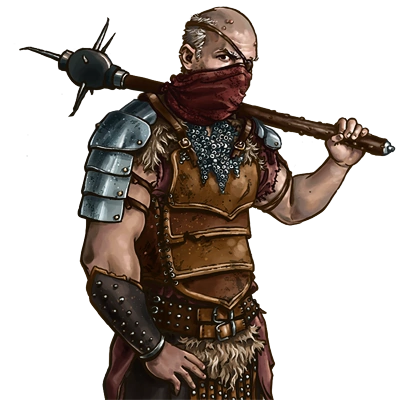Many players like to build their character in D&D surrounding a theme, and I can’t blame them; making characters in D&D is fun by itself, but making one with a theme forces you to be innovative. I have met several players with this mindset, and one of the most iconic builds is a pyromancer-based character. It’s like a play on a famous quote; you can play with fire and get your enemies burned instead of you!
Making a pyromancer-based character may seem difficult, but it is easy thanks to the abundance of fire spells in D&D (Fire Bolt, Wall of Fire, Scorching Ray, and more!). Sorcerers, Wizards, and even Artificers are effective classes to make them due to the spells available for them. If you are also considering making a build with a fire theme, I suggest picking up the spell featured in this Burning Hands 5e guide, a level one evocation DnD spell.
With Burning Hands, you can spread hot flames from your fingertips, burning everything to a crisp, even your enemies! Even if your character is not pyromancer-themed, having this spell with you on hand can save you in many unexpected situations. I think having something to burn stuff with is always helpful, and Burning Hands is one of them. This guide will teach you how and when to use it.
Bottom Line Up Front: What is Burning Hands in D&D 5e?
Burning Hands is a level one evocation spell you can find in the Player’s Handbook on page 220. This spell is an evocation D&D spell similar to Mass Cure Wounds and Thunderclap because it manipulates the energy around the caster to produce fire from their hands. Below are the crucial facts about the Burning Hands spell in D&D 5e.
- Burning Hands
- Level one evocation
- Casting Time: One action
- Range: 15-foot cone from self
- Components: V, S
- Duration: Instantaneous
How to use Burning Hands in D&D 5e
You need to meet Burning Hand’s requirements first before flames can shoot from your outstretched fingertips. Below is a concise list you must consider to continue casting the spell.
- You must know the Burning Hands spell or have it prepared: Like all the other spells, you need to have Burning Hands in your magical arsenal. Some classes, such as the Bard and Sorcerer, have spells fixated in their mind, while others, like the Wizard and Cleric, prepare them from their spell list.
- You must have at least a level one spell slot to cast Burning Hands: You need to use a spell slot when casting spells, and the spell slot must be of the same level as the spell or even higher. Burning Hands’ effects change upon using a higher-level spell slot.
- You need to use your action during combat to cast Burning Hands: The spell has a casting time of one action.
- You need to speak freely in an audible voice to cast Burning Hands: The Burning Hands spell requires a verbal component.
- You need to move your arms freely to cast Burning Hands: The Burning Hands spell requires the somatic component.
If you complete all these requirements, you can cast Burning Hands at the cost of a spell slot, and its effects happen instantaneously. With your character’s thumbs touching, thin sheets of flames spread out from your stretched-out fingertips.
Everyone and everything within a 15-foot cone from yourself become affected. If you want to know what the affected targets need to do, read the next section.
How does Burning Hands work in D&D 5e?
As the thin sheets of flames reach out towards the people in a 15-foot cone from you, the following effects occur:
- An affected creature makes a Dexterity saving throw vs. your Spell Save DC: They roll a d20 and add their Dexterity saving throw modifier to the result to get their Dexterity saving throw.
- The affected creature compares the result to your Spell Save DC: Your Spell Save DC depends on your class since it relies on your spellcasting ability. I have listed them for the different classes and subclasses in the “Who can cast Burning Hands in D&D 5e?” section. If the result is equal to or higher than your Spell Save DC, they succeed. Otherwise, they fail.
- If they fail, they receive 3d6 fire damage: Roll three six-sided dice, add the results, and subtract the target’s HP by the sum. For example, you roll five, three, and six for the Burning Hands’ fire damage, adding up to 14. Therefore, the target’s HP goes down by 14. Vulnerabilities, immunities, and resistances to fire damage are applied if applicable.
- If they succeed, they receive half of the 3d6 fire damage: In relation to the example in the previous point, a target succeeding in the Dexterity saving throw would receive seven fire damage instead of 14.
- Flammable objects within the spell’s area of effect that are not worn or carried ignite: For example, a hay bale on the ground within the spell’s area of effect (i.e., 15-foot cone from you) ignites and burns. However, wooden armor worn by a target affected by the spell or a wooden shield carried by them does not ignite.
- The Burning Hands’ damage increases depending on the spell slot level used: Suppose you use a spell slot with a level higher than one to cast Burning Hands, the damage increases by 1d6 per level. For example, using a level three spell slot to cast Burning Hands would cause 5d6 fire damage instead of 3d6 since there are two levels to three after one.
Burning Hands is a straightforward spell; it deals fire damage and ignites flammable objects. You can imagine it to be like a magical flamethrower, but the fire comes out of your fingertips instead. Still, I can understand how some would find it confusing. The next section contains example scenarios about someone casting this spell to showcase how it works in simulated combat.
Example scenario for using Burning Hands in D&D 5e
Welcome to Arthur’s Lab, where we answer your burning questions about the Burning Hands spell in D&D 5e. Along with us in our experiment are Marshal the Half-elf Wizard and a couple of bandits who “tagged” along for the sake of discovery.
Marshal has the spell in his spell list and has it prepared; his fingers are ready to spread flames around the lab. Below are the necessary details about these participants.
Marshal

- Intelligence modifier: +3
- Proficiency bonus: +2
- Spell Save DC: 8 + 3 (Intelligence modifier) + 2 (proficiency bonus) = 13
Bandits
- HP: 30/30
- Dexterity saving throw modifier: +2
First scenario: Marshal casts Burning Hands
It’s Marshal’s turn, and he decides to cast Burning Hands toward the bandits; he uses a level one spell slot to cast it. If you are using a square grid for combats in D&D, it may seem confusing as to what the 15-foot cone from Burning Hands would look like. You can angle your Burning Hands to spread diagonally, like in the picture below.
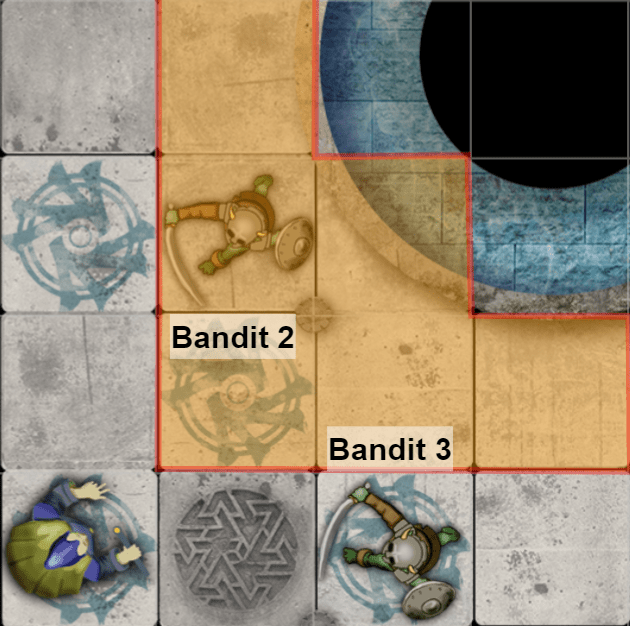
Or, you can angle it to spread forward, like the picture below. In this case, Marshal spreads the flames forward to hit Bandits 1 and 2. Since Bandit 3 is outside the spell’s area of effect, the spell does not affect him. Otherwise, every flammable object within the 15-foot cone ignites.
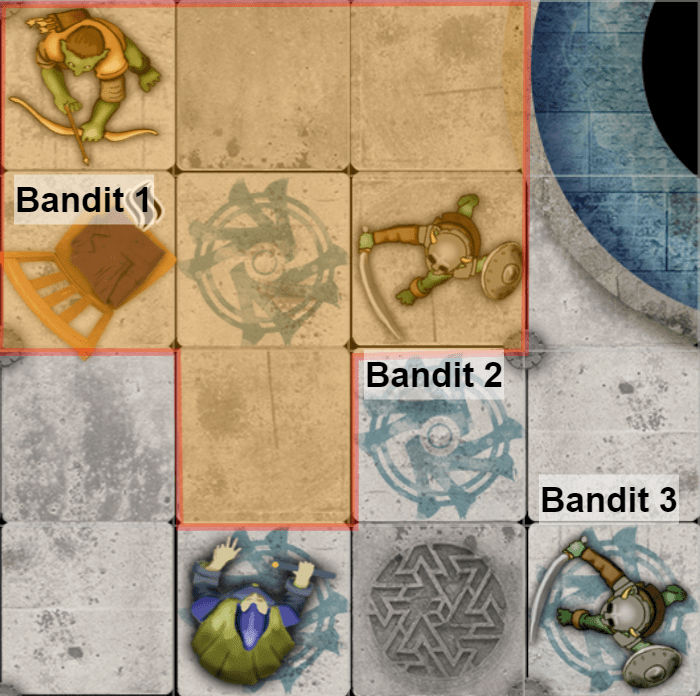
Second scenario: Burning Hands ignite flammable objects
Aside from dealing fire damage, the Burning Hands spell ignites flammable objects within its area of effect. In this demonstration, Marshal’s spell hits Bandits 1 and 2 alongside a wooden chair nearby. Since wood is easily flammable, it ignites a fire. If it were made of a non-flammable material like iron or stone, the spell would not affect it.
Furthermore, flammable objects worn or carried by anyone within the area do not ignite. In this demonstration, the bandits’ clothes do not burn away even if they are made of cloth and leather since the bandits are wearing them. The shirt on the chair, on the other hand, burns. Furthermore, the flammable items carried by the bandits, like Bandit 1’s bow, do not burn since he is carrying it.
Third scenario: Bandit 1 fails Burning Hands’ Dexterity saving throw
Bandit 1 is within Marshal’s Burning Hands; therefore, he rolls a d20 to make a Dexterity saving throw and gets a ten. Bandit 1 also has a modifier to his saving throw, which we can add to the result. In other words, we calculate his final Dexterity saving throw as follows:
- Dexterity saving throw = d20 + Dexterity saving throw modifier
- Dexterity saving throw = 10 + 2
- Dexterity saving throw = 12
Since Bandit 1’s Dexterity saving throw of 12 is lower than Marshal’s Spell Save DC of 13, he fails the saving throw and receives 3d6 fire damage. So, Marshal rolls three six-sided dice to calculate the damage and gets two and five with a sum of 11. Thus, Bandit 1 receives 11 fire damage, lowering his HP.
If Bandit 1 was vulnerable to fire damage, he would receive 22 fire damage instead. If he has resistance to it, he will receive five fire damage instead. Having an immunity would net zero fire damage. Since Bandit 1 has neither of these statuses, he receives 11 fire damage like normal.
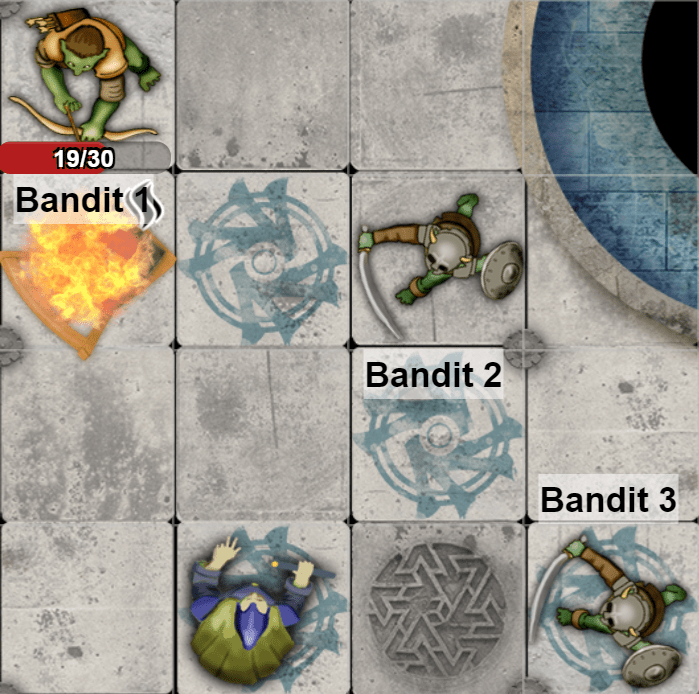
Fourth scenario: Bandit 2 succeeds Burning Hands’ Dexterity saving throw
Bandit 2 is also within Marshal’s Burning Hands. He also rolls a d20 to make a Dexterity saving throw and gets a 12. Like Bandit 1, he has a Dexterity saving throw modifier, and we calculate the final result as follows:
- Dexterity saving throw = d20 + Dexterity saving throw modifier
- Dexterity saving throw = 12 + 2
- Dexterity saving throw = 14
Bandit 2 succeeds in his Dexterity saving throw since his result of 14 is higher than Marshal’s Spell Save DC of 13. Therefore, he receives half the fire damage Bandit 1 received, i.e., Bandit 2 receives five fire damage. If he had resistance to fire damage, his HP would go down by two instead. Also, as per the rules of D&D 5e, you should always round down your results unless stated otherwise.

Fifth scenario: Marshal casts Burning Hands using a higher-level spell slot
We skip the bandits’ turns as they have decided not to move, and it is Marshal’s turn again. Marshal casts Burning Hands once more, but this time, he uses a level two spell slot. According to the spell’s rules, casting the spell using a higher-level spell slot increases its damage by 1d6 for each level after level one.
In this scenario, using a level two spell slot to cast Burning Hands would add 1d6 fire damage, turning it from 3d6 to 4d6. Also, his sole target this time is Bandit 2, as he positions the spell as shown in the picture below. After rolling for his Dexterity saving throw and adding up the modifier, he fails the save.
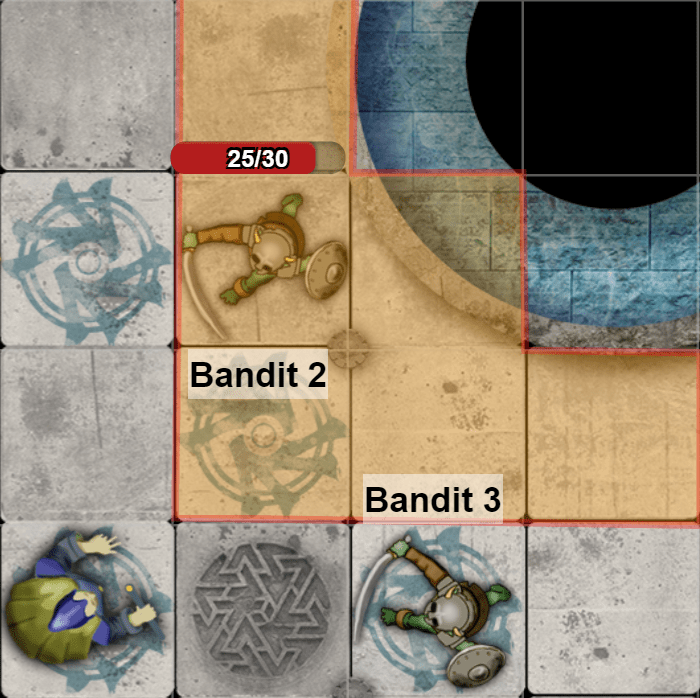
Marshal rolls four six-sided dice and gets six, two, four, and three. Therefore, Bandit 2’s HP goes down from 25 to ten thanks to Burning Hands’ 15 fire damage.
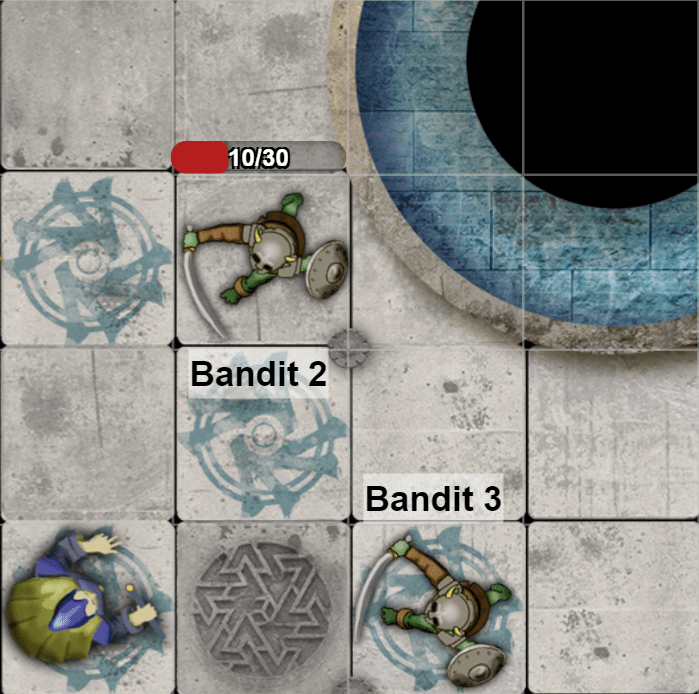
Who can cast Burning Hands in D&D 5e?
Two classes (Sorcerer and Wizard), eight subclasses (Arcane Trickster Rogue, Eldritch Knight Fighter, Fiend Warlock, Four Elements Monk, Efreeti Genie Warlock, Light Cleric, Sun Soul Monk, and Wildfire Druid), three races (Fire Genasi, Mephistopheles Tiefling, and Hellfire Tiefling), and one background (Rakdos Cultist) can learn the Burning Hands spell.
Classes that can cast Burning Hands in D&D 5e
Sorcerers and Wizards can learn the Burning Hands spell since it is part of their spell list. However, wizards must prepare the spell first if they want to use it during battle. Both classes have level one spell slots as early as level one. Below is a table with info about these classes, like their source and Spell Save DC.
|
Classes that can cast Burning Hands |
Class Source |
Spell Save DC |
| Sorcerer | Player’s Handbook, page 99 | 8 + your Charisma modifier + your proficiency bonus |
| Wizard | Player’s Handbook, page 112 | 8 + your Intelligence modifier + your proficiency bonus |
Subclasses that can cast Burning Hands in D&D 5e
The Arcane Trickster Rogue, Eldritch Knight Fighter, Fiend Warlock, Four Elements Monk, Efreeti Genie Warlock, Light Cleric, Sun Soul Monk, and Wildfire Druid have access to the Burning Hands spell in D&D 5e thanks to one of their subclass features. Additionally, one subclass from Unearthed Arcana can also have it. Below is a table containing info for each subclass, such as their source and Spell Save DC.
|
Subclasses that can cast Burning Hands |
Originating Class | Subclass Feature for Burning Hands | Subclass Source | Class Source |
Spell Save DC |
| Arcane Trickster | Rogue | Spellcasting | Player’s Handbook, page 97 | Player’s Handbook, page 94 | 8 + your Intelligence modifier + your proficiency bonus |
| Eldritch Knight | Fighter | Spellcasting | Player’s Handbook, page 74 | Player’s Handbook, page 70 | 8 + your Intelligence modifier + your proficiency bonus |
| The Fiend | Warlock | Expanded Spell List | Player’s Handbook, page 109 | Player’s Handbook, page 105 | 8 + your Charisma modifier + your proficiency bonus |
| Way of the Four Elements | Monk | Elemental Disciplines | Player’s Handbook, page 80 | Player’s Handbook, page 76 | 8 + your Wisdom modifier + your proficiency bonus |
| The Genie (Efreeti) | Warlock | Expanded Spell List | Tasha’s Cauldron of Everything, page 73 | Player’s Handbook, page 105 | 8 + your Charisma modifier + your proficiency bonus |
| Light Domain | Cleric | Light Domain Spells | Player’s Handbook, page 60 | Player’s Handbook, page 56 | 8 + your Wisdom modifier + your proficiency bonus |
| Way of the Sun Soul | Monk | Searing Arc Strike | Xanathar’s Guide to Everything, page 35 | Player’s Handbook, page 76 | 8 + your Wisdom modifier + your proficiency bonus |
| Circle of Wildfire | Druid | Circle of Wildfire Spells | Tasha’s Cauldron of Everything, page 39 | Player’s Handbook, page 64 | 8 + your Wisdom modifier + your proficiency bonus |
| Giant Soul (Fire) | Sorcerer | Mark of the Ordning | Unearthed Arcana: Giant Soul Sorcerer, page 1 | Player’s Handbook, page 99 | 8 + your Charisma modifier + your proficiency bonus |
Arcane Trickster Rogues and Eldritch Knight Fighters can cast spells from the Wizard spell list after obtaining their Spellcasting subclass feature, and since Burning Hands belong to that list, they can pick it up. The Eldritch Knight Fighter can pick this spell anytime they learn a new one because Burning Hands is an evocation spell.
However, Arcane Trickster Rogues can only pick up enchantment and illusion spells, so they cannot pick up Burning Hands as freely as the Eldritch Knight Fighter. Instead, they can pick it up when they reach levels 3, 8, 14, and 20 since the spells they get during these levels can be of any school of magic.
Warlocks whose patron is either The Fiend or The Efreeti Genie have access to Burning Hands thanks to their Expanded Spell List subclass feature; it grants them a number of spells that are automatically added as part of their spell list. Burning Hands is not a part of the Warlock spell list, but thanks to this subclass feature, they have access to it.
As the name suggests, the Genie Warlock must choose the Efreeti as the Genie Kind since their element is fire. Only the Efreeti Genie grants the Warlock with the Burning Hands spell as part of the Expanded Spell List.
Monks who have committed themselves to the Way of the Four Elements can cast Burning Hands in a non-traditional way. Typically, Monks cannot cast spells, but they have a system involving their ki that allows them to cast spells through it: their Elemental Disciplines subclass feature. These disciplines gather the power of the four elements to imitate the effects of existing spells.
The Elemental Discipline that allows them to cast Burning Hands is the Sweeping Cinder Strike. To use it, they must spend two ki points. Additionally, once they reach level five, they can use additional ki points to increase the damage; for every one ki point added, the fire damage increases by 1d6.
Monks who committed themselves to the Way of the Sun Soul can cast Burning Hands thanks to their Searing Arc Strike subclass feature, which they get upon reaching level six. It allows them to cast Burning Hands as a bonus action after attacking during their turn at the cost of two ki points. They can also increase the spell’s damage through the same method of adding ki points like the Four Elements Monks.
Finally, Clerics in the Light Domain and Druids in the Circle of Wildfire have the Burning Hands spell always prepared thanks to the Light Domain Spells and Circle of Wildfire Spells subclass features, respectively. Typically, these classes have to prepare spells to cast them. Plus, Burning Hands is not part of their spell list.
Their respective subclass features give them a number of spells that are always prepared for them. Furthermore, these spells do not count against their prepared spells count. Light Clerics get Burning Hands as always prepared starting at level one, while Wildfire Druids have it always prepared starting at level two.
Races that can cast Burning Hands in D&D 5e
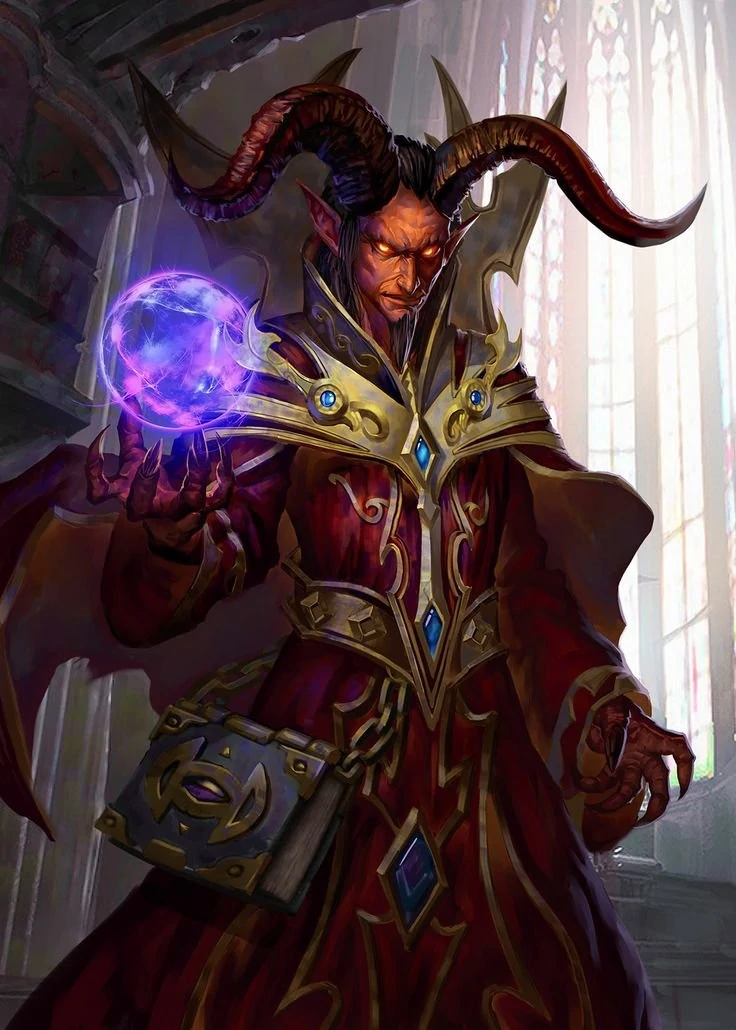
The Fire Genasi, Mephistopheles Tiefling, and Hellfire Tiefling can cast Burning Hands through their racial features. Their necessary details are neatly displayed in the table below.
|
Races that can cast Burning Hands |
Racial Feature for Burning Hands | Race Source |
Spell Save DC |
| Fire Genasi | Reach to the Blaze | Elemental Evil Player’s Companion, page 9 | 8 + your Constitution modifier + your proficiency bonus |
| Mephistopheles Tiefling | Legacy of Cania | Mordenkainen’s Tome of Foes, page 23 | 8 + your Charisma modifier + your proficiency bonus |
| Hellfire Tiefling | Hellfire | Sword Coast Adventurer’s Guide, page 118 | 8 + your Charisma modifier + your proficiency bonus |
The Fire Genasi can cast Burning Hands thanks to their Reach to the Blaze racial feature; when they reach level three, it allows them to cast it as a level one spell. They cannot cast it again until they finish a long rest, i.e., they can use it once per long rest.
The Mephistopheles Tiefling and Hellfire Tiefling can cast Burning Hands thanks to their Legacy of Cania and Hellfire racial features, respectively; similar to the Fire Genasi, both races can cast this spell when they reach level three, and they can use it once per long rest. However, both races cast this spell as a level two spell. Thus, the Burning Hands from these racial features deal 4d6 fire damage.
Backgrounds that can cast Burning Hands in D&D 5e
Characters with the Rakdos Cultist background have access to Burning Hands thanks to their Rakdos Guild Spells background feature. It adds Burning Hands and other numerous spells to their class’s spell list. The character with this background must be a spellcaster in the first place since this background feature only adds the spell to their pool of availability as part of their spell list.
For example, a Monk with this background cannot cast the Burning Hands spell using the Rakdos Guild Spells background feature because they cannot cast spells in the first place. The Burning Hands spell becomes available alongside Dissonant Whispers and Hellish Rebuke when the character can cast level one spells.
To read more about this background, refer to the Guildmaster’s Guide to Ravnica on page 79. Keep in mind that this background belongs in the Ravnica setting; therefore, picking this background while playing a game set in a different setting like Forgotten Realms would not make sense. Always ask your DM first if they will allow you to pick the Rakdos Cultist as your character’s background.
Creative and useful ways to use Burning Hands in D&D 5e
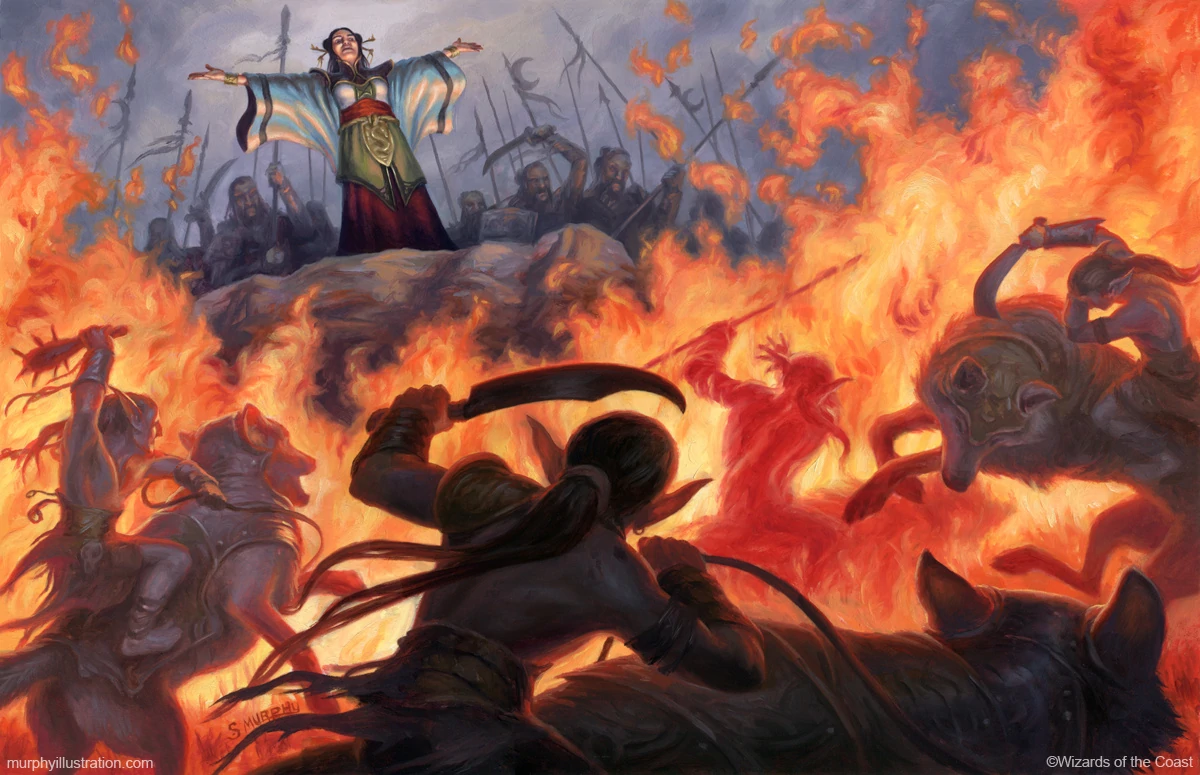
The Burning Hands spell deals a lot of fire damage to potentially a lot of people, so it would be wise to use it during appropriate times. While you can cast it during battle and net good results, many players would still worry about the right opportunity to use it. Thus, below is a list of valuable methods to cast Burning Hands in D&D 5e.
Avoiding close encounters using Burning Hands in D&D 5e
Spellcasters are known to be squishy individuals, especially at lower levels; one blow from a club would make them dance around the thread between life and death. Thus, it is always advisable for spellcasters to be far from dangerous elements and cast spells from a distance. However, you sometimes cannot avoid enemies flocking toward you. Maybe they see you as a threat because of your magical abilities.
If a lot of enemies are near you, Burning Hands can deter them from attacking you, especially if many of them are already low on health. If you are using square grids for battles, the spell can cover six to seven tiles. Therefore, six to seven enemies close together and near you would make good barbeque for Burning Hands. As long as your targets fail their Dexterity saving throws, the spell will leave a huge dent.
Damaging many enemies in narrow paths using Burning Hands in D&D 5e
Burning Hands is the perfect tool to use in narrow paths like corridors, hallways, and more because you can guarantee it will hit many enemies packed in such small areas. The perfect width of such paths would be ten ft. wide because sending a 15-foot cone of flames forward covers the entire width. However, it can be a dangerous feat to go to the front to burn your enemies.
Similarly, you can also damage a lot of enemies, flanking you through a narrow pathway. Another good way to cast it would be through an entrance like a door or gate. You can potentially make it hazardous for them to enter or exit a building!
Burning buildings or structures using Burning Hands in D&D 5e
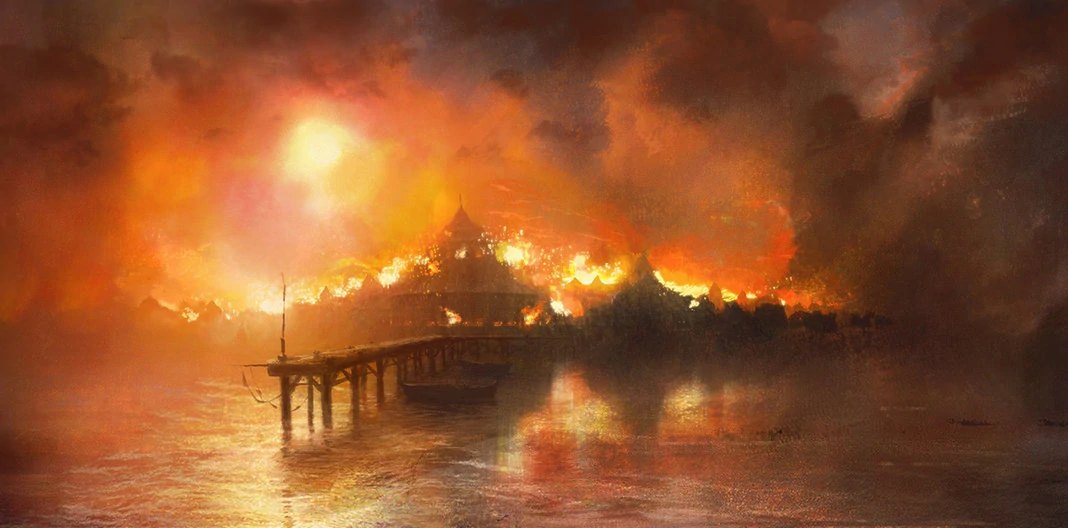
It is the middle of the night, and most of your enemies are sleeping peacefully inside a hut made of mostly flammable objects like wood, hay, and cloth. The best way to take care of them using a single spell would be Burning Hands. It sounds brutal and may look like a war crime, but always ask your DM if the Geneva Conventions exist in your game; if not, burn your enemies while they dream peacefully!
To make this method of eliminating your enemies more effective, make sure to cover any openings or passages they may exit from, like the windows or doors. If they do not die from the flames, they will certainly die from the fumes; it will also make your DM frantically look for a way to deal with your method of inhumane fighting.
Aside from burning buildings, you can also use Burning Hands to destroy structures like rope bridges, locked wooden doors, and more. Suppose your enemies are crossing the bridge you crossed to get to you; you can burn it down and watch them fall to their demise. If your DM is as ruthless as you, they may even face death as rapid rivers, or stony spikes welcome them below. Am I a brutal player? Probably.
Making signals and campfires using Burning Hands in D&D 5e
Using a level one spell slot to make a campfire is a bit silly, I admit since there are cantrips out there that can ignite flammable objects like Fire Bolt and Create Bonfire. If you use Fire Bolt, you can light up as many campfires as you want. However, if, for some reason, you do not have access to these cantrips, Burning Hands would be the next best option.
You can even use Burning Hands to ignite something as a signal. For example, a Fire Genasi might burn a pine tree to signal a nearby troop that it is the opportune time to attack a defenseless enemy base. By having Burning Hands, you can take up other cantrips instead.
Frequently Asked Questions
Question: Which is better, Burning Hands vs. Scorching Ray in D&D 5e?
Answer: Assuming both spells use level two spell slots, I think scorching ray is better than burning hands. Scorching ray creates three rays of fire that can hurt someone as far as 120 ft. Away from you. Plus, each ray deals 2d6 fire damage. You decide where your rays hit, so if you hurl all three rays at a single target, it can deal 6d6 fire damage. In terms of range and damage, scorching ray is better.
However, you can cast burning hands using a level one spell slot. Scorching ray is a level two spell; therefore, you cannot cast it at a lower level. If you are only left with level one spell slots, you are out of options for fire damage. Furthermore, burning hands ignite flammable objects while scorching ray cannot. Still, I think scorching ray is better.
QUESTION: CAN WARLOCKS HAVE BURNING HANDS IN D&D 5E?
Answer: Yes, warlocks can have burning hands in d&d 5e through specific subclasses, specifically the fiend and genie warlock. Typically, they cannot get their hands on it since it is not part of their spell list. However, thanks to the mentioned subclasses, it becomes added to their spell list. Read more about these subclasses in the “subclasses that can cast burning hands in d&d 5e” section above.
QUESTION: DOES BURNING HANDS REQUIRE TWO HANDS IN D&D 5E?
Answer: It depends on your dm if he will allow you to cast burning hands using only one hand in d&d 5e. Somatic spells only need one hand to create gestures for magic. According to the spell’s description, though, the caster connects their thumbs while their fingers are spread out. However, many view this part of the spell as flavor text, I.E., it does not affect gameplay mechanics. Still, ask your dm first.
Conclusion: Is Burning Hands a good spell in D&D 5e?
For a level one spell, I think the Burning Hands spell is a good one in D&D 5e because of its damage output. On average, you can deal 10.5 fire damage to an enemy. If the area of effect affects six or seven people, you can expect around 63 fire damage to give to them in total. Plus, it is versatile since you can cast it using a higher-level spell slot to make it more powerful. However, it has its flaws and weaknesses.
Something that irks me about this spell is its range; a 15-foot cone emerging from you does not reach too far. It is useful in close encounters, but as a spellcaster, you mostly spend your time away from the clashing swords. Compared to Scorching Ray, it is a bit inferior even when we use level two spell slots for both spells to give them equal grounds.
Would I pick this level one spell up as part of my magical arsenal? I can see myself using it from time to time. It can have many applications and be a lifesaver when you need it most. Burning stuff up is fun (at least for me); since it is illegal in the real world, you can express your desire in the fantasy world of D&D!
- Giant Eagle 5e Guide - November 21, 2022
- Destructive Wave 5e Guide - November 9, 2022
- Burning Hands 5e Guide - October 1, 2022


